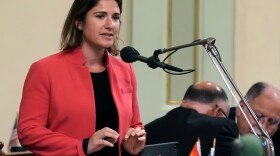Walk onto the factory floor of incept3D in Mira Mesa and you hear the low din of machines and see more than 100 3D printers in action.
The printers are making everything from replicas of human bones to housings for electronics to tap handles for San Diego breweries.
“It’s basically a very sophisticated hot glue gun,” said Michael Armbruster, founder and CEO of Incept3D. Armbruster explained the process as he pointed at a thermoplastic cord role on a 3D printer.
“You’ve got filament that goes up through a tube," Armbruster said. "And it comes out of this very tiny nozzle. The 3D printer will then travel along the X & Y plane, depositing that filament onto the part. And then, it will stack each layer on the one before it and that — in a nutshell — is how 3D printing works.”
The printer nozzle darts across the object making, in this case, a mold for a cement structure. Some objects are made in 24 hours, while some are made overnight. Armbruster said he got hooked into 3D printers 10 years ago, because he loved making things and immediately saw the potential of 3D printing.
“I was just blown away that this technology completely disregards complexity as a challenge," he said. " (Printing) a part can be very simple or a part can be very complex. The machines simply don’t care. You can then build any shape that would then apply to any industry that needs to make things.”
He said 3D printing is great as long as manufacturers are making a diversity of products or small volumes of the same thing. It cannot compete with conventional manufacturing if it were to make 10,000 identical items. Factories using preset molds can punch out product a lot faster.

Caroline Freund is an economist at UC San Diego, where she is dean of the School of Global Policy and Strategy. She has studied how 3D printing has affected trade, and says it has increased international trade among those products that are commonly printed.
She said 3D printing excels at the innovation end of product creation.
“3D printing allows you to design many, many, many parts and components and then test them," Freund said. "You can design them on the computer, print them out, find which one is the best, then develop a mold and use that for your mass production."
And then there are products where each needs to be a little bit different.
“3D printers can customize products because you can literally scan whatever you need and then individualize that product,” Freund said. “One really good example of this customization is in hearing aids, where you can scan the cavity of someone’s ear, and create a product that uniquely fits that ear.”
Another example is making artificial limbs, which is what San Diego-based Limber Prosthetics and Orthotics (P&O) does. UC San Diego Engineering doctoral student Joshua Pelz is the CEO of Limber P&O.
During a visit to his lab, he held up an artificial leg made of cream-colored plastic.
“This is the Limber UniLeg,” Pelz said. “It is a single-leg prosthesis that is 3D printed in just half of a day. So you can press start at night. And you pull it off looking just like this in the morning ready to go on to an amputee, letting them get back out in the world.”
Another co-founder of Limber P&O is Herb Barrack, a prosthetist who used to carve artificial limbs out of balsa wood. The 3D-printed legs are based on data that comes from a digital scan of the amputee’s lower limbs.

“The digital process allows us to duplicate alignment," Barrack said. "We print the prosthesis and, the majority of the time, our alignment is very, very close to the desired alignment."
Back at incept3D, Michael Armbruster showed the printed spine of a young child, based on CT scans from a children’s hospital. It's part of preparation for surgery on the child. Next to it is a printed skull, modeled on one that was damaged in an accident. The client in this case is a personal injury attorney.
Ambruster said while 3D printing seems innovative, it’s not new technology.
“So the technology is actually incredibly old," Armbruster said. "It was there in the ‘80s and ‘90s and it was just as good as it is today. But it was this tiny little market that only the most high-end people would use. But then some patents expired — some big ones. The ones that allow for all of this. And that’s when all the attention came to this industry.”
While Armbruster said 3D technology has been static, there is a new frontier when it comes to printing products.
In medicine, organic printing of some body parts like heart valves are in development. Some construction companies are beginning to make 3D-printed houses. It works off a computer program, of course, but their “printer” pours cement.





